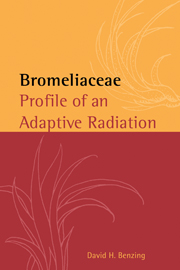Book contents
- Frontmatter
- Contents
- List of contributors
- Preface
- Acknowledgments
- Glossary
- Abbreviations
- Part one Brief overview
- Part two Basic structure, function, ecology and evolution
- Part three Special topics
- 10 Neoregelia subgenus Hylaeaicum
- 11 Cryptanthus
- 12 Tillandsioideae
- 13 Tillandsia and Racinaea
- 14 Ethnobotany of Bromeliaceae
- 15 Endangered Bromeliaceae
- Literature cited
- Name index
- Subject index
- Taxon index
10 - Neoregelia subgenus Hylaeaicum
from Part three - Special topics
Published online by Cambridge University Press: 19 January 2010
- Frontmatter
- Contents
- List of contributors
- Preface
- Acknowledgments
- Glossary
- Abbreviations
- Part one Brief overview
- Part two Basic structure, function, ecology and evolution
- Part three Special topics
- 10 Neoregelia subgenus Hylaeaicum
- 11 Cryptanthus
- 12 Tillandsioideae
- 13 Tillandsia and Racinaea
- 14 Ethnobotany of Bromeliaceae
- 15 Endangered Bromeliaceae
- Literature cited
- Name index
- Subject index
- Taxon index
Summary
Neoregelia, with about 100 species (Luther and Sieff 1996), belongs to subfamily Bromelioideae, and consists of two subgenera with largely nonoverlapping ranges: Neoregelia with about 90 species and subgenus Hylaeaicum with 10 species. Subgenus Neoregelia is confined to eastern Brazil except for one species each in northern Venezuela (N. cathcartii) and Amazonian Peru (N. johnsoniae). Subgenus Hylaeaicum is entirely Amazonian in parts of Colombia, Venezuela, Peru, Ecuador and Brazil.
Neoregelia is distinguished from the other bromelioid genera with nidular inflorescences (Canistrum, Nidularium and Wittrockia) by its asymmetric sepals and lack of petal appendages (Leme 1998a,b). However, more recent studies (Ramírez 1991, 1994) have determined that petal appendages occur in members of subgenus Hylaeaicum, and Leme (1997) reported these same organs in subgenus Neoregelia (N. carolinae), indicating need to re-evaluate the taxonomic utility of this character.
Taxonomic problems
Nidularium eleutheropetalum and N. myrmecophilum were successively assigned to different sections of Nidularium, and the genera Karatas and Aregelia until in 1890 Lindman placed them in genus Regelia, which he created by elevating the status of Nidularium subgenus Regelia Lemaire. In 1891 Kuntze had proposed the name Aregelia as a nomen novum for Nidularium, so that its typification must be identical to that of Nidularium. Therefore Mez's decision to use Aregelia for a genus segregated from typical Nidularium is invalid.
Genus Regelia was named after the German botanist A. von Regel, who served as superintendent of the Imperial Botanic Gardens in St Petersburg, Russia. Because the name Regelia had already been assigned to three species of Myrtaceae, Smith (1934b) created the name Neoregelia, considering Regelia Lindman and Aregelia Mez, 1896 non Kuntze, 1891, to be synonyms.
- Type
- Chapter
- Information
- BromeliaceaeProfile of an Adaptive Radiation, pp. 545 - 550Publisher: Cambridge University PressPrint publication year: 2000



